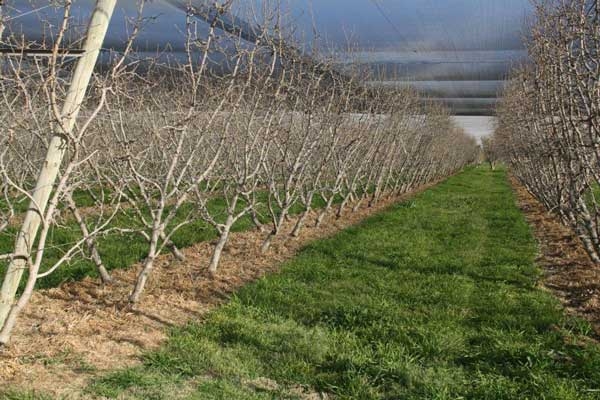Winter weeds are a cheap way of improving the soil and adding organic matter to soil.
It is costly and difficult to sow a cover crop on the tree-line, so let winter weeds do the job for you.
Most weeds support beneficial arbuscular mycorrhizal (AM) fungi, as do most other flowering plants.
The hyphae (filaments) of these AM fungi grow in the soil and in the root. In return the plant supplies the fungi with organic carbon from photosynthesis, all continually mixing organic matter with soil without cultivation.
The hyphae and roots hold particles of sand, silt and clay together into stable soil aggregates.
To see this, pull a clump of weeds out of moist soil, where you will see aggregates of soil clinging to the hyphae and roots (Figure 1).
The hyphae also help the root to take up nutrients and water.
High turnover of weed roots & hyphae
As with other normal healthy plants, there is a high turnover of weed roots and hyphae (especially grasses).
The hyphae and roots do not live long, but are replaced by new hyphae and roots, so continually add organic matter to the soil.
Roots also exude simple organic materials which are quickly used by soil organisms close to the roots, i.e. in the rhizosphere.
Weeds as mulch
Simply and cheaply allow weeds to grow in winter (Figure 2), but kill them with herbicide in spring (Figure 3) so that they will not compete with the tree roots for nutrients, water and space.
Slash the dead weeds in the traffic-line, and throw the slashings up onto the tree-line to mulch the surface soil.
Fauna such as earthworms will gradually mix the organic residues with the soil. In this way you will build up organic matter in the tree-line and protect the soil surface from heavy raindrops.
That is, the stable covered soil will not erode, water and nutrients will not be wasted in runoff, and a dense hard impermeable crust will not form on the soil.
The organic mulch of dead weeds in the tree-line:
- cools the top 50 mm of soil in summer, and avoids temperatures that are lethal to roots
- decreases evaporation from the surface of the soil, although some of the water saved, is lost by deep drainage
- stores more water in the soil
- keeps the soil well aerated
- provides extra storage space for tree-roots that grow up into the mulch
- improves soil structure
- protects the soil from lethal high temperatures in summer.
Straw mulches are costly to apply, but also mulched soil without fine roots from live weeds or a cover crop becomes hard and restricts tree roots, even though the soil is stable.
Soil hilling
If your surface soil is shallow and overlies heavy subsoil, (e.g. a Red-brown earth) you should hill the surface soil from the traffic-line—where few tree roots grow—up onto the tree-line, where most of the feeder-roots grow.
If your soil is deep and permeable, do not hill-up the soil, which would only waste time and money.
With a high-density planting, the soil in the tree-lines is packed with feeder-roots, which can only function properly if the soil contains adequate water, nutrients and oxygen.
In a high- density planting it is therefore much more important to create and maintain a stable well-structured soil for high sustainable production of fruit than it is for widely-spaced (dinosaur) trees.






















